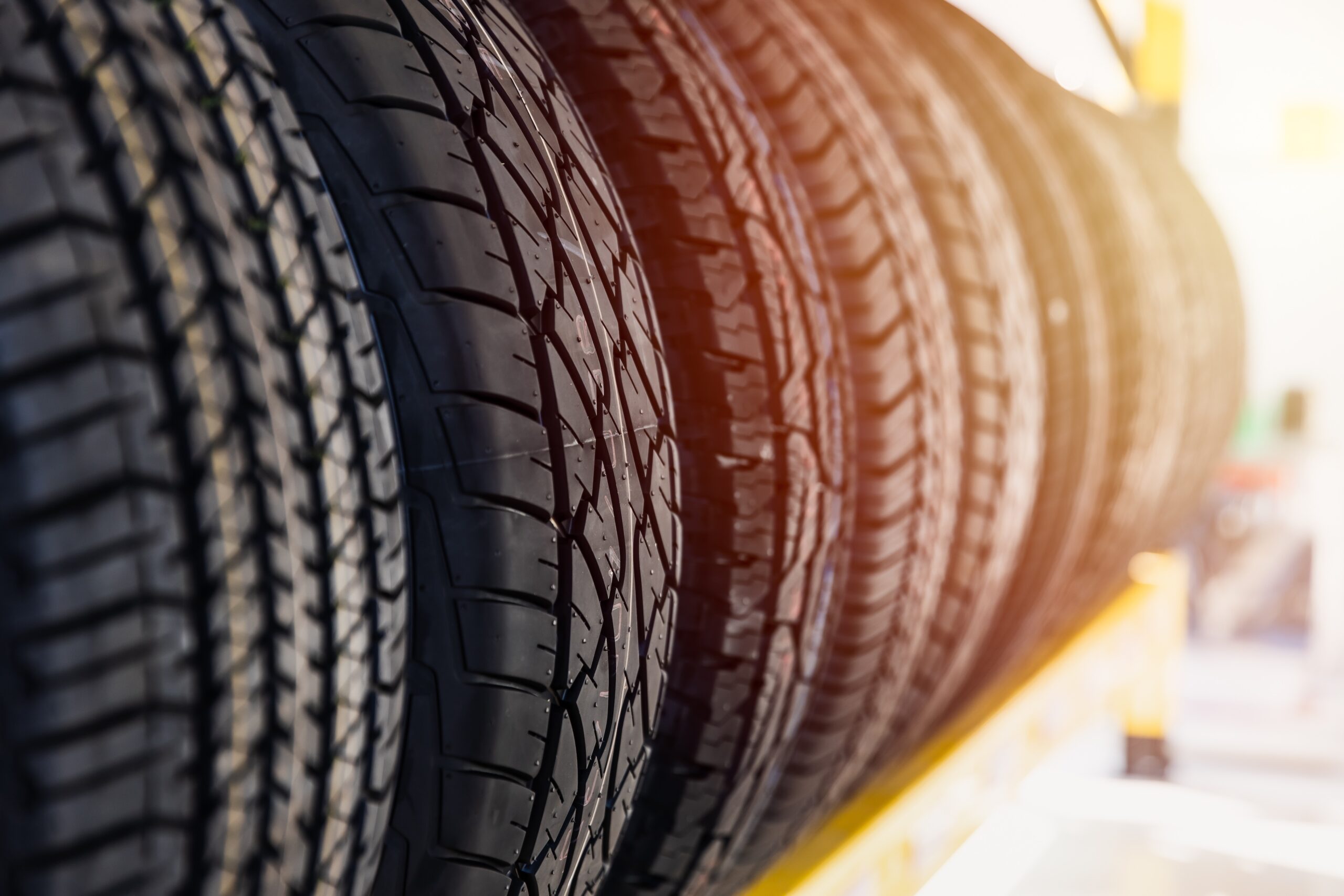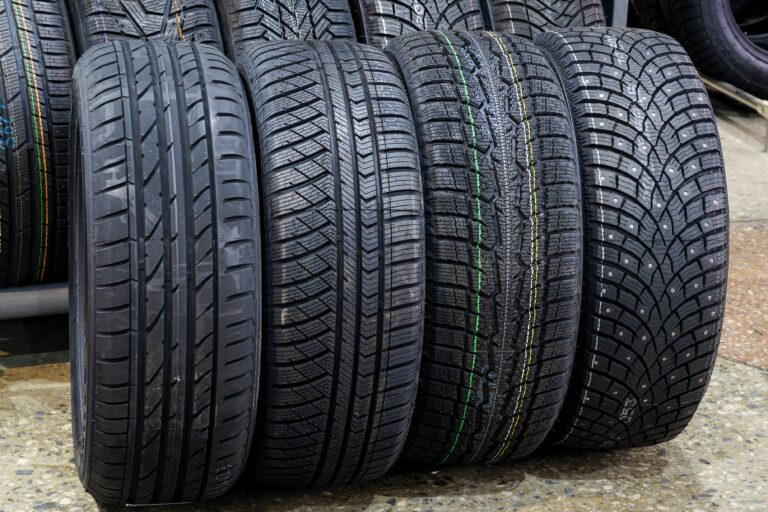How to Get the Longest Life from Your Tires

Your tires are one of your vehicle’s most important investments and one of the easiest to protect. Proper tire maintenance saves you money by extending the life of your tires as well as improving your car’s safety, fuel efficiency, and performance. With a few simple habits and regular inspections, you can help your tires go the distance.
Here’s everything you should know about how to extend tire life and keep your vehicle performing at its best year-round.
Why Proper Tire Care Matters
Tires are the only part of your vehicle that actually touch the road, so their condition directly impacts how your car handles, brakes, and accelerates. Poorly maintained tires wear unevenly, reduce traction in wet or slippery conditions, and can even cause suspension or steering issues over time. They can also require premature replacement and lower fuel economy
On the other hand, consistent care helps:
- Improve fuel efficiency by reducing rolling resistance
- Enhance safety with better grip and stopping performance
- Save money by extending tread life and avoiding premature replacements
When it comes to tire care, prevention is always cheaper (and safer) than waiting for a problem to appear.
Key Habits to Help Your Tires Last Longer
Even small changes in your maintenance routine or driving habits can make a big difference in tire longevity. Here are the most effective ways to protect your investment.
Keep Your Tires Properly Inflated
Tire pressure directly affects tread wear and vehicle efficiency.
- Underinflated tires will flex more, causing sidewall stress and uneven tire wear
- Overinflated tires can reduce traction by decreasing center touchpoints and result in a stiffer, rougher ride
You should check for proper tire pressure at least once per month, and always before long road trips or major temperature changes. You can find your vehicle’s recommended tire pressure, or PSI, inside your driver’s side door or the vehicle’s owner’s manual.
If you drive a modern vehicle, it should be equipped with a tire pressure monitoring system, or TPMS. If your low tire pressure indicator light is illuminated on the dashboard, take it to Telle to diagnose and repair the issue, whether it’s due to a pressure change caused by temperature fluctuations or a defect in the tire that is causing a leak.
Rotate Your Tires Regularly
Each tire wears differently depending on its position on your vehicle. Rotating them helps even out that wear pattern, improving performance and lifespan. For most drivers, getting tires rotated every 5,000 to 7,500 miles (or every other oil change) is sufficient.
During Telle’s tire rotation services, we’ll ensure proper rotation patterns to increase tire life, provide a smoother ride, and achieve better traction across all four wheels.
Get Regular Wheel Alignments
Misaligned wheels are one of the most common culprits behind premature tire wear. Even slight misalignment can cause your vehicle to pull to one side or create uneven tread wear patterns. Regular alignment checks will help keep your steering responsive and your tires lasting longer.
Some signs you may need wheel alignment service include:
- Steering wheel feels crooked when driving straight
- Vehicle drifting or pulling to one side
- Uneven or rapid tread wear
Check Your Suspension & Steering Components
Your tires rely on your suspension and steering systems to maintain proper contact with the road, which directly affects how evenly the tread wears. When parts like shocks, struts, ball joints, or tie rods begin to wear out, they can cause your tires to bounce, tilt, or drag in ways that accelerate tread wear and reduce handling performance.
Some common warning signs that your suspension or steering may need attention include:
- Uneven or “cupped” tread wear patterns
- A vibrating or shaky steering wheel when driving at higher speeds
- The vehicle pulls to one side when driving straight
- Clunking or knocking sounds over bumps
- A rougher or bouncier ride than usual
Driving with worn suspension components wears down your tires faster, makes your vehicle less stable, and increases your stopping distance. Scheduling regular steering and suspension inspections is crucial, especially if you drive frequently on rough roads or notice any changes in ride comfort or handling.
Drive Smoothly & Avoid Road Hazards
How you drive affects how your tires wear. Every sharp corner, sudden brake, or quick acceleration adds unnecessary stress to your tread and sidewalls. Over time, that stress can cause uneven wear, reduce traction, and shorten your tires’ lifespan. Smooth, consistent driving helps preserve both your tires and your vehicle’s overall performance.
Try to ease into starts and stops rather than slamming on the gas or brakes. When cornering, slow down gradually instead of taking turns at high speeds or hard braking at the last moment. These simple driving habits reduce friction and heat buildup in your tires, which are two of the main causes of premature wear.
It’s also important to be mindful of what’s on the road. Potholes, curbs, and debris can cause tire damage or even knock your wheels out of alignment. Whenever possible, give yourself enough space and time to avoid obstacles safely; if you can’t, slow down before impact to minimize the force on your tires and suspension.
Store Tires Properly (If Seasonal or Spare)
If you switch between all-season and seasonal tires (winter or summer), or keep a full-size spare on hand, how you store these tires can make a big difference in how long they last. Tires are made of natural rubber and synthetic compounds that degrade when exposed to sunlight, heat, or moisture. Improper storage can lead to cracking, flat spots, or dry rot, which weaken the tire’s structure and shorten its usable life.
Here are some tips to properly store tires:
- Keep them in a cool, dry, and dark place, like a climate-controlled garage or basement.
- Avoid placing them in areas near furnaces, windows, or electric motors, as heat and ozone can accelerate deterioration.
- Tires mounted on wheels can be hung or stacked horizontally, and should have positions alternated every few months. Unmounted tires should be stored upright to prevent deformation.
Before storage, clean your tires thoroughly to remove dirt, road salt, and brake dust, then let them dry completely. You can also use tire bags or airtight plastic covers to help reduce exposure to oxygen and humidity.
How to Know When It’s Time for Tire Replacement
Even with the best maintenance habits, tires eventually reach the end of their safe lifespan. Knowing when to replace them is crucial, as worn tires reduce traction and handling, as well as increase the risk of blowouts or accidents, particularly in wet or icy conditions.
Check Tread Depth
Tread depth is the most important factor in determining tire safety. Most tires start with 10/32″ to 12/32″ of tread, but they become unsafe in wet weather when the depth reaches 4/32″. Once the tread measures 2/32″, they become unsafe in any driving conditions, and is the legal minimum in most states requiring immediate replacement.
You can easily check tread depth by doing the penny test (or quarter test), or visiting Telle Tire to have it professionally evaluated with a tread depth gauge. If using a coin, the tread should be covering the top of Lincoln’s or Washington’s head; if the top of Washington’s head is exposed, you’re below the 4/32″ measurement, and if the top of Lincoln’s head is exposed, your tires are below the legal depth.
Look for Visible Damage
Inspect your tires for any signs of physical damage, including:
- Cracks or splits in the sidewalls or tread
- Bulges or blisters, which indicate internal damage
- Embedded objects, such as nails or glass, that could cause a slow leak
- Uneven tread wear patterns may indicate alignment, inflation, or suspension issues.
Any of these issues can compromise the tire’s structural integrity, making replacement the safest choice.
Monitor Performance Changes
Pay attention to how your tires feel while driving. Worn tires may:
- Reduce braking performance, especially in wet or slippery conditions
- Cause your car to handle poorly in turns or at higher speeds
- Make the vehicle feel less stable, especially in crossroads or on uneven roads
If you notice any of these warning signs, it’s time for a professional inspection.
Professional Tire Inspections
Even if your tires look fine on the surface, internal wear or hidden damage can reduce their safety and lifespan. Visiting Telle Tire for a professional inspection ensures that any issues are caught early. Our technicians measure tread depth, check for uneven wear, inspect suspension impacts, and advise you on whether a replacement is needed, helping you avoid surprises on the road and maximize the life of your next set of tires.
Common Questions About Extending Tire Life
How often should I rotate my tires?
Most vehicles need tire rotation every 5,000–7,500 miles, or about every six months. Check your owner’s manual for your vehicle’s specific recommendation.
What’s the best tire pressure for my car?
Your ideal tire pressure is listed on a sticker inside your driver’s door or in your owner’s manual — not on the tire itself. Keep it at that recommended PSI for the best performance and longevity.
Do wheel alignments really help my tires last longer?
Yes. Proper alignment ensures all four tires meet the road evenly, preventing premature wear and improving your vehicle’s handling and fuel efficiency.
Can I make my tires last longer by driving slower?
Driving at moderate speeds and avoiding aggressive maneuvers reduces friction and heat buildup — both of which extend tire life. Smooth, steady driving always benefits your tires.
Keep Your Tires Rolling Longer with Telle Tire
From tire rotations to alignments and pressure checks, Telle Tire makes it easy to keep your vehicle safe, smooth, and efficient. Whether you’re looking for expert advice or hands-on tire care, our team is here to help your tires last longer, mile after mile.
Take it to Telle today and drive with confidence knowing your vehicle is in expert hands.

Take it to telle
Stay Safe with a Tire Check from Telle Tire
Worried about your tread depth or tire condition heading into the summer storm season? Take it to Telle. Our expert technicians can assess your tires, check pressure levels, and recommend replacements when necessary, helping you stay in control regardless of the weather conditions. Stay safe, stay prepared, and if you’re unsure about your tires, schedule a visit with your nearest Telle Tire & Auto Centers location today.
Stay Informed
Recent Articles from Telle Tire

Best Tires for Missouri Weather: All-Season vs Winter Tires
Missouri’s weather can surprise you. One week, you’re driving on a mild, sunny fall day, and the next, you’re navigating icy roads or puddles after a…

Do Electric Vehicles Need Special Tires?
Electric vehicles (EVs) have become a common sight on the road, offering drivers an eco-friendly, high-performance alternative to gas-powered cars. As more EV models become available…

Tire Rotation vs. Alignment: What You Really Need (And How to Tell)
If you’ve ever been told your car needs a tire rotation or wheel alignment, you might have wondered—aren’t those basically the same thing? While both services…
